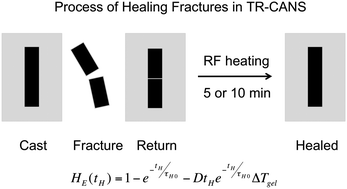Understanding the process of healing of thermoreversible covalent adaptable networks†
Abstract
When Diels–Alder-based thermoreversible covalent adaptable networks (TR-CANs), are applied in fracture healing applications, the contributions of network structure tend to take a back seat to explanations based solely on the chemical behaviour of the reversible bonds binding the network. However, for TR-CANs near the gel point, rheological experiments have shown that accounting for network structure via scaling relationships is necessary to understand their viscoelastic behaviour. By extension, the structure of the network should have a substantial effect on fracture healing performance. In this work we demonstrate this effect in a model hysteresis heated Diels–Alder network material. The effective functionality of the monomers was varied from 3.0 to 3.5, changing the gel temperature from 106 °C to 122 °C. By subjecting these materials to identical healing conditions, we observed the change due to network structure while holding e.g. bond conversion and bond lifetime constant. We showed with statistical confidence that both healing time, and the interaction between healing time and composition (p = 0.016 and p = 0.014, respectively) are necessary to explain the observed differences in healing performance. A single-parameter model of healing was developed based on the scaling relationship that determined mechanical relaxation, and the model was interpreted to understand how network structure and fracture healing interact in TR-CANs.

- This article is part of the themed collection: Self-healing polymers

 Please wait while we load your content...
Please wait while we load your content...